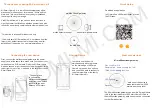
DDNG485
To reduce the risk of fire or electric shock, do not expose this device to rain or moisture. Installation, programming and maintenance must be
carried out by qualified personnel. All local wiring and electrical regulations must be followed when installing device.
Overview
•
Powered by DyNet –
Mains supply not required.
•
Two optically isolated RS485 Ports –
3.75 KV isolation.
•
Powerful internal PLC –
Custom scripts can be written to
provide process control based on conditional logic.
•
DMX integration –
Receives up to 64 DMX channels.
•
DIN rail mounting –
Six units wide.
•
Many control options –
Device is controllable via a combination
of methods, including a serial control port, relay contacts, wall-
mounted user interfaces, infrared receivers and timeclocks.
Network Gateway
Read Instructions
– We recommend that you read this guide prior
to commencement of installation.
Warning
– This is a class A product. In a domestic environment
this product may cause radio interference in which case the user
may be required to take adequate measures.
Special Programming
– Once powered and terminated correctly
this device will only operate in basic mode. Advanced functions are
commissioned via the Envision software. If commissioning services
are required, contact your local distributor.
Check Connections
– Tighten all load-bearing screw connections,
as vibrations from transport can cause the terminal block screws to
loosen.
Mounting Location
– Install in a dry, well-ventilated location.
Data Cable
– Use screened, stranded RS485 data cable with three
twisted pairs. Segregate from mains cables by at least 300mm.
Connect devices in a ‘daisy chain’ configuration. A data cable that
is connected to an energized device is live. Do not cut or terminate
live data cables.
Electrical Diagram
+12V
D +
D -
GND
SHIELD
µP
Port 1
RS485
DyNet
+12V
D +
D -
GND
SHIELD
Port 2
RJ12 Socket
Port 2
RS485
DyNet
DMX512
AUX
Installation Steps
1. Mount the device on a DIN rail inside an appropriate enclosure.
Alternatively there are 3 holes provided to fix the device to a
surface without the use of DIN rail. Remove the front cover to
access these holes. Pull back the DIN rail clip detail to reveal
the mounting holes.
2. Connect data cables to the device as per diagrams. Note that
the device is powered from the DyNet network segment that is
connected to Port 1. When implementing Repeaters, connect
the link to Port 2 of both Gateways. Shielded cable must be
used for long runs. When implementing Trunk / Spur topology,
connect the Trunk to Port 2 and the Spur to Port 1. Note that
up to 375mA of power from the DyNet network on Port 1 is fed
to Port 2, so provided there is surplus power available on the
Spurs it is normally not necessary to provide a network power
supply for the Trunk.
3. If using the device as a DMX receiver, ensure DMX termination
rules are obeyed and use a 120 Ω terminating resistor across
the D+ and D- terminals at the end of the line. Note that Port 2
should be used for DMX Reception.
DDNG485
Network Gateway
DDNG485
Network Gateway
DyNet - Up to 800m
To network devices
To network devices
DDNG485
DDNG485
Example of repeaters
The maximum recommended length for DyNet cables between two
network bridges is 800 meters. For cable runs over 300 meters or
baud rates over 9600 bps, a 120 Ω end-of-line resistor must be
installed across the D+ and D- terminals of the DyNet connector strip
on the last device. For more information, contact Philips Dynalite.
DyNet Cable Length




















